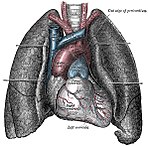
| Home | Sources Directory | News Releases | Calendar | Articles | | Contact | |
Anatomy
| Wikiversity has learning materials about Topic:Anatomy |
Anatomy (from the Greek á��î�î��„î¿î�î�î� anatomia, from á��î�î��„î�î�î�î�î�î� ana: separate, apart from, and temnein, to cut up, cut open.) is a branch of biology and medicine that is the consideration of the structure of living things. It is a general term that includes human anatomy, animal anatomy (zootomy) and plant anatomy (phytotomy). In some of its facets anatomy is closely related to embryology, comparative anatomy and comparative embryology,[1] through common roots in evolution.
Anatomy is subdivided into gross anatomy (or macroscopic anatomy) and microscopic anatomy.[1] Gross anatomy (also called topographical anatomy, regional anatomy, or anthropotomy) is the study of anatomical structures that can be seen by unaided vision with the naked eye.[1] Microscopic anatomy is the study of minute anatomical structures assisted with microscopes, which includes histology (the study of the organization of tissues),[1] and cytology (the study of cells).
The history of anatomy has been characterized, over time, by a continually developing understanding of the functions of organs and structures in the body. Methods have also improved dramatically, advancing from examination of animals through dissection of cadavers (dead human bodies) to technologically complex techniques developed in the 20th century including X-ray, ultrasound, and MRI imaging.
Anatomy should not be confused with anatomical pathology (also called morbid anatomy or histopathology), which is the study of the gross and microscopic appearances of diseased organs.
Contents |
[edit] Superficial anatomy
Superficial anatomy or surface anatomy is important in anatomy being the study of anatomical landmarks that can be readily seen from the contours or the surface of the body.[1] With knowledge of superficial anatomy, physicians or veterinary surgeons gauge the position and anatomy of the associated deeper structures.
[edit] Human anatomy


Human anatomy, including gross human anatomy and histology, is primarily the scientific study of the morphology of the adult human body.[1]
Generally, students of certain biological sciences, paramedics, prosthetists and orthotists, physiotherapists, occupational therapy, nurses, and medical students learn gross anatomy and microscopic anatomy from anatomical models, skeletons, textbooks, diagrams, photographs, lectures and tutorials. The study of microscopic anatomy (or histology) can be aided by practical experience examining histological preparations (or slides) under a microscope; and in addition, medical students generally also learn gross anatomy with practical experience of dissection and inspection of cadavers (dead human bodies).
Human anatomy, physiology and biochemistry are complementary basic medical sciences, which are generally taught to medical students in their first year at medical school. Human anatomy can be taught regionally or systemically;[1] that is, respectively, studying anatomy by bodily regions such as the head and chest, or studying by specific systems, such as the nervous or respiratory systems. The major anatomy textbook, Gray's Anatomy, has recently been reorganized from a systems format to a regional format,[2][3] in line with modern teaching methods. A thorough working knowledge of anatomy is required by all medical doctors, especially surgeons, and doctors working in some diagnostic specialities, such as histopathology and radiology.
Academic human anatomists are usually employed by universities, medical schools or teaching hospitals. They are often involved in teaching anatomy, and research into certain systems, organs, tissues or cells.
[edit] Other branches
- Comparative anatomy relates to the comparison of anatomical structures (both gross and microscopic) in different animals.[1]
- Anthropological anatomy or physical anthropology relates to the comparison of the anatomy of different races of humans.
- Artistic anatomy relates to anatomic studies for artistic reasons.
[edit] See also
General anatomy:
- Anatomical terms of location
- Body plan
- Foundational Model of Anatomy
- History of anatomy
- Important publications in anatomy
- List of anatomical topics
- Superficial anatomy
- Cat anatomy
- Fish anatomy
- Bird anatomy
- Spider anatomy
[edit] Notes
- ^ a b c d e f g h "Introduction page, "Anatomy of the Human Body". Henry Gray. 20th edition. 1918". http://www.bartleby.com/107/1.html. Retrieved 19 March 2007.
- ^ "Publisher's page for Gray's Anatomy. 39th edition (UK). 2004. ISBN 0-443-07168-3". Archived from the original on 2007-10-12. http://web.archive.org/web/20071012104507/http://intl.elsevierhealth.com/catalogue/title.cfm?ISBN=0443071683. Retrieved 19 March 2007.
- ^ "Publisher's page for Gray's Anatomy. 39th edition (US). 2004. ISBN 0-443-07168-3". http://www.us.elsevierhealth.com/product.jsp?isbn=0443071683. Retrieved 19 March 2007.
[edit] References
[edit] External links
| At Wikiversity you can learn more and teach others about Anatomy at: |
- Musculoskeletal Anatomy
- Online anatomy atlas
- Get Body Smart
- Anatomy Atlases ' a digital library of anatomy information
- Anatomia 1522'1867: Anatomical Plates from the Thomas Fisher Rare Book Library
- Anatomy of the Human Body Gray, Henry. Philadelphia: Lea & Febiger, 1918
- High-Resolution Cytoarchitectural Primate Brain Atlases
- Anatomy Mnemonics Mnemonics in Anatomy.
- Anatomy in the 16th century studies and digitized texts by the BIUM (Bibliothèque interuniversitaire de médecine et d'odontologie, Paris) see its digital library Medic@.
- 19th Century Anatomy Lesson Animated dissection following Gray's Anatomy
|
||||||||||||||||||||||||||||||||||||||||||||||||||||||||
|
SOURCES.COM is an online portal and directory for journalists, news media, researchers and anyone seeking experts, spokespersons, and reliable information resources. Use SOURCES.COM to find experts, media contacts, news releases, background information, scientists, officials, speakers, newsmakers, spokespeople, talk show guests, story ideas, research studies, databases, universities, associations and NGOs, businesses, government spokespeople. Indexing and search applications by Ulli Diemer and Chris DeFreitas.
For information about being included in SOURCES as a expert or spokesperson see the FAQ . For partnerships, content and applications, and domain name opportunities contact us.

